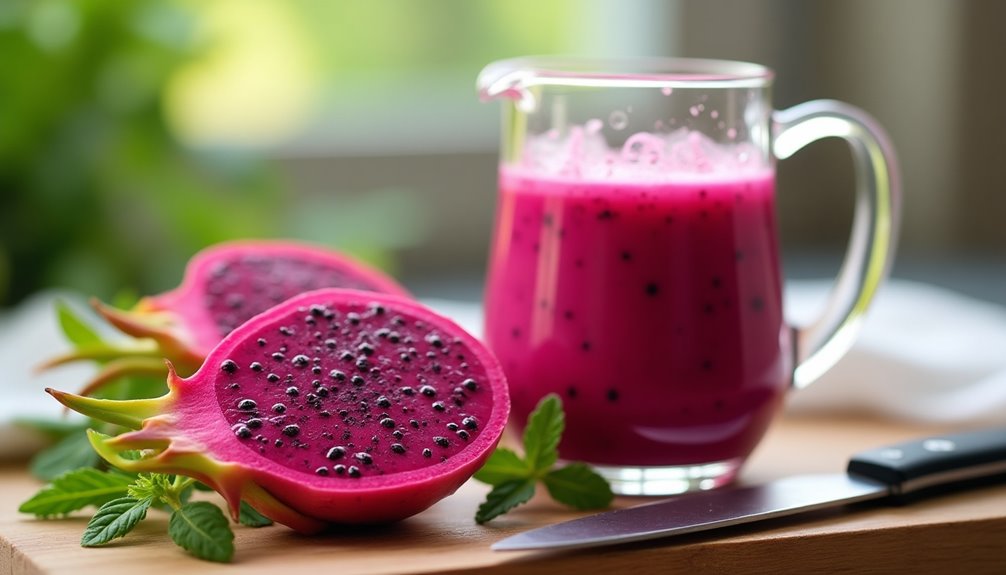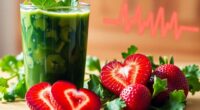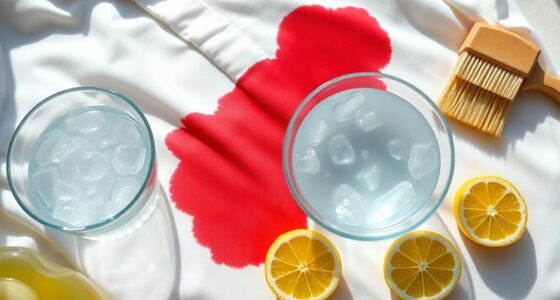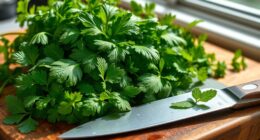To make dragon fruit juice, start by cutting a ripe dragon fruit in half and scoop out the pulp with a spoon. Cube the flesh, and blend with a splash of lemon juice, adjusting sweetness with sugar or honey as desired. If it's too thick, add water for a smoother consistency. Pour the juice over ice in a tall glass, garnishing with a lemon slice or mint leaves. There's plenty more to discover about enhancing this tropical treat.
Key Takeaways
- Select a ripe dragon fruit, cut it in half, and scoop out the flesh for blending.
- Cube the dragon fruit pulp and optionally add lemon juice, sugar, or honey for flavor.
- Blend the pulped dragon fruit and enhancements until the mixture is smooth, adjusting consistency with water if needed.
- Serve the juice over ice in a tall glass, garnished with a lemon slice or mint leaves.
- Store any leftover juice in the refrigerator for up to four days, ensuring it's well-sealed.

Making dragon fruit juice is a simple and delicious way to enjoy this exotic fruit. With its vibrant pink skin and speckled flesh, dragon fruit isn't just eye-catching; it's packed with nutrients and flavor. You're going to love how easy it's to transform this tropical fruit into a refreshing drink that's perfect for any occasion.
To start, you'll need a ripe dragon fruit. Look for one that's slightly soft to the touch but not mushy. Once you've got the fruit, cut it in half to reveal the beautiful pulp inside. Use a spoon to scoop out the flesh, being careful to leave the skin behind. After you've scooped out the pulp, cube it into smaller pieces. This'll make it easier to blend and ensure a smooth texture in your juice.
Next, it's time to bring out the flavors. Take your dragon fruit cubes and toss them into a blender. To enhance the taste of your juice, add a splash of lemon juice. This citrusy touch not only brightens the flavor but also adds a refreshing twist. If you enjoy a touch of sweetness, you can mix in some sugar or honey, depending on your preference. Honey gives a nice floral note, while sugar offers straightforward sweetness. You can also add some lemon zest for an extra burst of flavor that pairs beautifully with the dragon fruit.
Now, you’ll want to adjust the consistency of your juice. If it’s too thick, simply add a bit of water until you reach your desired thickness. Blend everything together until the mixture is completely smooth. This should only take a minute or two, but you can blend longer if you prefer a more liquid texture. Once you’ve achieved the right consistency, pour your juice into a glass or container of your choice. If you’re interested in how to prepare noni juice, make sure to incorporate ripe noni fruit, which can add a unique flavor and numerous health benefits. Enjoy your freshly made juice right away for the best taste and nutritional value!
Once you've got everything blended to perfection, taste your juice. If it's not sweet enough for your liking, feel free to add more sugar or honey and blend again.
To serve, pour your dragon fruit juice over ice cubes in a tall glass. The cold ice makes this drink even more refreshing, especially on a hot day. You can also garnish it with a slice of lemon or some mint leaves for a beautiful presentation.
If you've made more juice than you can drink, don't worry! You can store any leftovers in the refrigerator for up to four days. Just remember to stir well before serving again, as the ingredients may settle.
This dragon fruit juice recipe isn't just a treat for your taste buds; it's also a fantastic way to hydrate. The vibrant color and tropical flavor will have you feeling like you're sipping a vacation in a glass. So go ahead, create your refreshing dragon fruit juice, and enjoy every sip of this delicious tropical delight!
Frequently Asked Questions
Is Dragon Fruit Good for Juicing?
Yes, dragon fruit's great for juicing! Its mild sweetness and vibrant color not only make your juice visually appealing but also delicious.
You'll love how its high water content offers a refreshing drink, perfect for hot days. Plus, the antioxidants and vitamins in dragon fruit boost your health, while the dietary fiber aids digestion.
Combining it with other fruits can enhance the flavor and create a nutrient-rich beverage you won't want to miss!
What Is the Best Way to Prepare Dragon Fruit?
When you prepare dragon fruit, it's like unwrapping a vibrant treasure.
First, pick ripe fruit with smooth, colorful skin, gently squeezing for slight softness. Cut it in half and scoop out the dazzling pulp, aiming for minimal waste.
Cube the pulp for easier blending. Feel free to enhance the flavor with sweeteners and lemon juice, adjusting the consistency with water.
Blend until smooth, and you've got a refreshing, eye-catching treat ready to enjoy!
Do I Peel Dragon Fruit Before Juicing?
Yes, you should peel dragon fruit before juicing.
The skin's tough and not edible, so it's best to cut the fruit in half and scoop out the pulp. Discard the skin and cube the pulp roughly.
If you keep a bit of the pink layer while peeling, it'll enhance the juice's color and presentation.
Focus on extracting that sweet, mildly flavored flesh for a delicious drink you'll enjoy!
How to Make Dragon Fruit Vitamin Water at Home?
To make dragon fruit vitamin water at home, start by cutting a ripe dragon fruit in half and scooping out the pulp into a pitcher.
Blend the pulp with filtered water, adjusting for your preferred flavor strength.
Add slices of fresh lemon or lime and a handful of mint leaves for extra freshness.
If you like, sweeten it with honey or agave.
Chill the mixture for an hour, then serve it over ice.
Enjoy!
Conclusion
Once you've blended that vibrant dragon fruit into a refreshing juice, you'll feel like you've unlocked a treasure chest of tropical flavor. Just like a sunrise bursting through the clouds, each sip brings a bright burst of energy and vitality. Remember, making dragon fruit juice isn't just about quenching your thirst; it's about savoring a moment of natural delight. So grab your blender, and let this exotic fruit brighten your day! You won't regret it.
Cindy thoroughly researches juicing trends, techniques, and recipes to provide readers with practical advice and inspiration. Her writing style is accessible, engaging, and designed to make complex concepts easy to understand. Cindy’s dedication to promoting the advantages of juicing shines through her work, empowering readers to make positive changes in their lives through the simple act of juicing.











